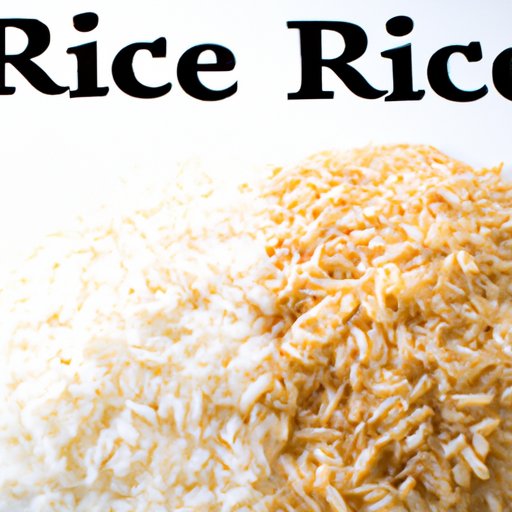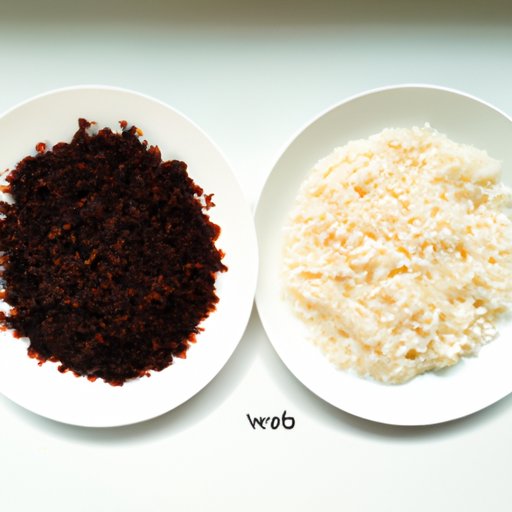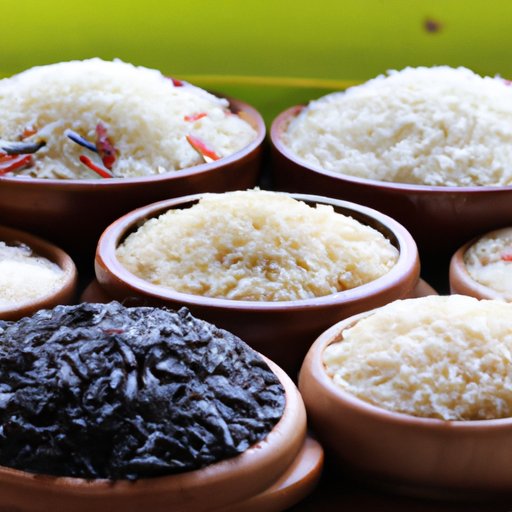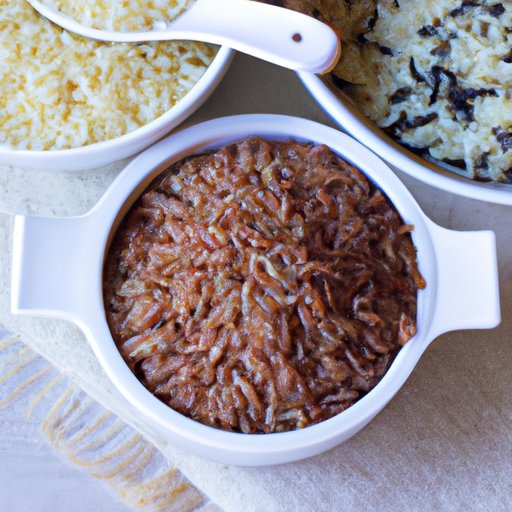Introduction
Rice is one of the most widely consumed grains in the world. It has been an important source of nutrition for centuries and is a staple food in many cultures. Rice is low in fat and contains essential vitamins, minerals, and fiber. However, there are different types of rice, and each type has its own unique nutritional benefits.
This article will explore the differences between brown and white rice and which type is healthier. We will compare the nutrient content of both types of rice, as well as the health benefits associated with each. Additionally, we will look at different types of rice and how they affect overall health.
Comparison of the Nutritional Benefits of Brown and White Rice
To understand the differences between brown and white rice, it’s important to first compare their nutrient content. Brown rice is considered a whole grain because it includes all three parts of the grain – the bran, the germ, and the endosperm. White rice, on the other hand, has had the bran and germ removed, leaving only the endosperm.
Nutritionally, brown rice is higher in fiber, magnesium, and other minerals than white rice. One cup (195 grams) of cooked brown rice contains 3.5 grams of fiber, compared to 0.4 grams in the same amount of white rice. Brown rice also contains more vitamin B6, potassium, and iron than white rice.
White rice is higher in carbohydrates, protein, and certain vitamins than brown rice. One cup (195 grams) of cooked white rice contains 45 grams of carbohydrates, compared to just over 40 grams in the same amount of brown rice. White rice is also higher in folate and thiamin than brown rice.
In terms of calories, both types of rice contain roughly the same amount. One cup (195 grams) of cooked brown rice contains 218 calories, while the same amount of white rice contains 205 calories.

Exploring the Health Benefits of Brown vs. White Rice
The fiber content of brown rice makes it a healthier option than white rice. Fiber helps to slow digestion and can keep you feeling fuller longer. Studies have shown that consuming high-fiber foods like brown rice can help reduce the risk of heart disease and diabetes, as well as aid in weight loss.
The glycemic index of brown rice is lower than that of white rice. The glycemic index is a measure of how quickly blood sugar levels rise after eating a particular food. Foods with a low glycemic index are digested slowly, which helps prevent spikes in blood sugar levels. This can be beneficial for those with diabetes or prediabetes.
Brown rice is also higher in antioxidants than white rice, which can help protect against chronic diseases such as cancer. According to a study published in the journal Food Chemistry, brown rice has higher concentrations of phenolic compounds and flavonoids than white rice.

The Pros and Cons of Eating Brown or White Rice
Both brown and white rice offer certain health benefits, but they also come with some drawbacks. Here are some of the pros and cons of eating either type of rice.
Pros of Eating Brown Rice
- High in fiber, which can help reduce the risk of heart disease and diabetes
- Lower glycemic index than white rice, which can help regulate blood sugar levels
- Higher antioxidant content than white rice, which can help protect against chronic diseases
Pros of Eating White Rice
- Higher in protein and certain vitamins than brown rice
- Easier to digest than brown rice
- Has a milder flavor, making it more versatile in recipes
Cons of Eating Brown Rice
- Can take longer to cook than white rice
- May have a bitter taste if not cooked correctly
- More expensive than white rice
Cons of Eating White Rice
- Lacks the nutrients found in brown rice
- Higher glycemic index than brown rice, which can cause a spike in blood sugar levels
- Lower antioxidant content than brown rice, which can reduce protection against chronic diseases

Different Types of Rice and Their Impact on Health
In addition to brown and white rice, there are other types of rice available, each with its own unique nutritional benefits. Here are some of the most popular varieties and their impacts on health.
Basmati Rice
Basmati rice is a long-grain rice that is popular in Indian and Middle Eastern cuisines. It is higher in fiber than white rice and has a lower glycemic index. Basmati rice is also rich in essential vitamins and minerals, including calcium, phosphorus, and magnesium.
Wild Rice
Wild rice is a type of grass seed native to North America. It is higher in fiber, protein, and certain vitamins than white rice. Wild rice also contains antioxidants and other phytochemicals that may help protect against chronic diseases.
Arborio Rice
Arborio rice is a short-grain rice that is often used to make risotto. It is higher in carbohydrates and protein than white rice and has a higher glycemic index. Arborio rice is also rich in manganese, phosphorus, and zinc.
Conclusion
Overall, brown rice is the healthier choice when compared to white rice. It is higher in fiber, minerals, and antioxidants, and has a lower glycemic index. While white rice lacks some of the nutrients found in brown rice, it is still a good source of carbohydrates, protein, and certain vitamins.
When choosing a type of rice, it’s important to consider your individual needs and preferences. Different types of rice offer unique nutritional benefits, so it’s best to experiment with different varieties to find the one that works best for you.
In conclusion, brown rice is the healthier choice when it comes to rice. It is higher in fiber and other essential nutrients, and has a lower glycemic index. However, white rice is still a good source of carbohydrates, protein, and certain vitamins. Ultimately, it’s up to you to decide which type of rice is right for you.
(Note: Is this article not meeting your expectations? Do you have knowledge or insights to share? Unlock new opportunities and expand your reach by joining our authors team. Click Registration to join us and share your expertise with our readers.)
